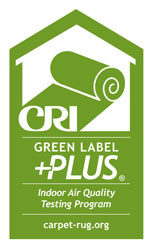Scope
In living spaces, utilize third-party certified low-emission carpet products that are designed to reduce human exposure indoors to individual VOCs. The How to Find Indoor airPLUS Compliant Low Emission Products document provides guidance on identifying compliant products including industry databases and examples of product labeling.
See the Compliance tab for links to related codes and standards and voluntary federal energy-efficiency program requirements.
Description
VOCs are emitted through off-gassing from many household products, including carpets and carpet adhesives. The How to Find Indoor airPLUS Compliant Low Emission Products document provides guidance on identifying compliant products including industry databases and examples of product labeling.
The Green Label Plus program tests carpets for emissions levels of 13 different chemicals, and tests carpet adhesives for 12 different chemicals. All Green Label Plus certified carpet and adhesives undergo a three-tier testing process, including follow-up testing to monitor continual compliance with emissions limitations.
As specified by the Green Label program, cushion products are characterized as prime polyurethane, bonded polyurethane, mechanically frothed polyurethane, rubber-hair, rubber–jute, synthetic fiber, resinated or coated synthetic fiber, rubber and rubberized polyurethane. Carpet cushions are tested for the following:
- total volatile organic compounds (TVOCs)
- butylated hydroxytoluene (BHT),
- formaldehyde,
- 4-phenylcyclohexine (4-PCH).
The maximum emissions limits for these are as follows:
- 1000 µg/m² hour for TVOCs,
- 300 µg/m² hour for BHT,
- 50 µg/m² hour for formaldehyde,
- 50 µg/m² hour for 4-PCH.

Green Label and Green Label Plus are independent product certification programs run by the Carpet and Rug Institute (CRI). These certifications include third party verification to ensure products meet strict emissions limits. Each certified product is listed in the CRI certified products database, located on their website at www.carpet-rug.org.

Using certified products lowers occupants’ risk of exposure to high levels of VOCs from construction materials. These Indoor airPLUS specifications can be implemented by requiring documentation of material certification for each material submittal package from sub-contractors. Any submittal requirements, such as manufacturer documentation of product certifications, should be clearly outlined in the project specifications and/or subcontractor bid package. Information for each third party certification and emissions standard required by Indoor airPLUS can be found in the How to Find Indoor airPLUS Compliant Low-Emission Products document.
Success
To ensure Indoor airPLUS Item 6.3 requirements are met, incorporate the requirements for product certification into the project’s specifications and/or bid package. Require documentation of product compliance for each product submittal from sub-contractors and suppliers.
Climate
No climate specific information applies.
Compliance
Compliance
Retrofit
SCOPE
Guidance for the measures described in this guide is applicable to both new and existing homes.
Follow safe work practices as described in the Global Worker Safety section of the Standard Work Specifications. Follow all manufacturer recommended measures for worker safety.
More
More Info.
Access to some references may require purchase from the publisher. While we continually update our database, links may have changed since posting. Please contact our webmaster if you find broken links.
The following authors and organizations contributed to the content in this Guide.
U.S. Environmental Protection Agency, Indoor airPlus program and PNNL.
Sales
Low/No VOC Carpets/Pads =

Carpet, carpet pads, and carpet adhesives can contain volatile organic compounds (VOCs) and other chemicals that have short- and long-term adverse health effects, including eye, nose, and throat irritation; headaches; loss of coordination and nausea; allergic skin reactions; and damage to the liver, kidneys, and central nervous system. Certified low/no-VOC carpets help provide for a healthy indoor environment. Programs like the Green Label Plus program, an independent product certification program run by the Carpet and Rug Institute (CRI), provide third-party certifications for VOC emissions tests.
